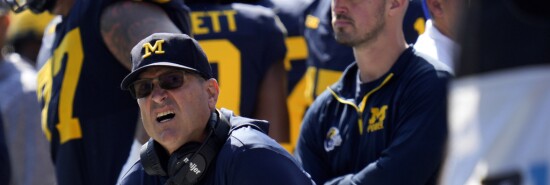
A 12-team playoff won’t fix college football, but this will
Conn Carroll
Video Embed
The last year of the four-team college football playoff will go down in infamy as one of the greatest injustices in college athletics.
An undefeated Florida State team, a team that scheduled and beat two Southeastern Conference teams this year, was left out of the playoffs in favor of an Alabama team that lost by 10 at home to Texas.
DESANTIS WARNS HOUSE GOP AGAINST USING BIDEN IMPEACHMENT INQUIRY AS ‘TROJAN HORSE’
The excuse given for picking the SEC team over Florida State — ESPN owns the rights to SEC football games — is that Florida State’s quarterback was injured three weeks ago in a game against North Alabama.
The decision itself, and the purported reasoning, not only betrays the integrity of on-the-field results but also creates huge perverse incentives for teams going forward. Why should teams ever be honest about the health of their players? Why would any team want to stay in a conference whose television rights aren’t owned by ESPN?
There are so many problems with the committee’s decision, but the player whose injury created this excuse should have a word. Florida State’s Jordan Travis tweeted this Sunday. “Devastated. Heartbroken. In so much disbelief rn, I wish my leg broke earlier in the season so y’all could see this team is much more than the quarterback. I thought results matter. 13-0 and this roster matches up across any team in those top 4 rankings. I am so sorry. Go Noles!”
But the four-team playoff is now behind us. Next year, there will be a 12-team playoff, so Florida State would have made it in — but at what spot?
Why is college football creating a new playoff system that continues to put huge amounts of power in a committee? Using this year’s final rankings, Florida State would be forced to play an extra game, while Alabama (and three other teams) get a bye. Why?
Why are we expanding the number of teams in the playoffs but continuing to allow a committee to favor some teams unjustly over others?
Can’t we settle this on the field?
Of course we can. But first, we need to blow up the abomination that is the current megaconference system.
It makes no geographical, historical, and definitely not academic sense to have the University of Southern California in the same conference as Maryland. Or to have California in the same conference as North Carolina. These megaconferences are driven entirely by television dollars and the inability of the NCAA to auction television rights collectively like the NFL does.
Imagine if the NFL didn’t exist and, instead, each division contracted with networks by themselves. With the NFL in place, it makes no sense for the NFC East to raid the NFC West for the Rams and the NFC North for the Bears. But without the NFL, it would make total sense for the NFC East to add the Los Angeles and Chicago markets and become a megadivision.
Would these megadivisions hurt the other football teams? Would the overall quality of professional football suffer with these megadivisions? Absolutely. And that is exactly what is happening to college football.
Someone with the power to overrule antitrust laws needs to come in and restore sanity to college football conferences.
And here is what those conferences could look like.
ACC
Maryland, Virginia, Duke, Wake Forest, North Carolina, North Carolina State, Clemson, South Carolina, Georgia Tech, Florida State.
Big East
Syracuse, Boston College, Notre Dame, Rutgers, Penn State, Pittsburgh, West Virginia, Cincinnati, Virginia Tech, Miami.
Big Ten
Minnesota, Wisconsin, Iowa, Illinois, Northwestern, Purdue, Indiana, Michigan State, Michigan, Ohio State.
Big West
BYU, Utah, Colorado, Nebraska, Oklahoma, Oklahoma State, Kansas, Kansas State, Missouri, Iowa State.
Pac-10
Washington, Washington State, Oregon, Oregon State, California, Stanford, USC, UCLA, Arizona, Arizona State.
SEC
LSU, Ole Miss, Mississippi State, Alabama, Auburn, Vanderbilt, Tennessee, Kentucky, Georgia, Florida.
Southwest
Texas Tech, Baylor, SMU, TCU, Texas, Texas A&M, Houston, Arkansas, Memphis, Louisville.
The playoffs would then be structured like this:
Big Ten champion and Pac-10 champion play in the Rose Bowl.
ACC champion and SEC champion would play in the Sugar Bowl.
Big East champion and Big West champion would play in the Orange Bowl.
Southwest champion and one at-large team would play in the Cotton Bowl.
The at-large team would be determined by the team with the fewest losses and most nonconference wins against other playoff conference opponents.
So here is how the playoff would look this year:
Michigan and Washington in the Rose Bowl.
Florida State and Alabama in the Sugar Bowl.
Penn State and Oklahoma in the Orange Bowl.
Texas and Ohio State in the Cotton Bowl.
Why Ohio State over Georgia (these are the only two one-loss schools that didn’t win their conference)? It has nothing to do with how each team “looks” and everything to do with their nonconference schedule. Ohio State beat Notre Dame. Georgia beat Georgia Tech. Notre Dame was a ranked team when the schools played, and they are a ranked team now. It is a better win.
More importantly, though, this system would incentivize schools to schedule more nonconference games with playoff conference schools. Instead of Georgia playing Ball State, the University of Tennessee at Martin, and the University of Alabama at Birmingham, maybe they’d schedule a real game. The result would be better games across the board for all schools.
CLICK HERE TO READ MORE FROM THE WASHINGTON EXAMINER
Most importantly, no playoff team would be given an unfair advantage over another team. No team would get a bye awarded by a committee. Instead, every school would have a fair shot of making the playoffs by winning their conference.
If we are going to expand the playoffs, let’s do it in a way that cuts our corrupt committees entirely.
